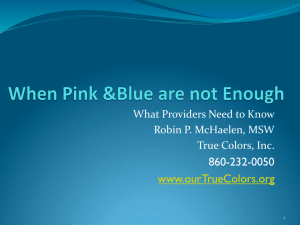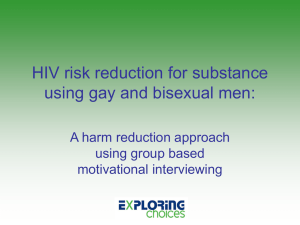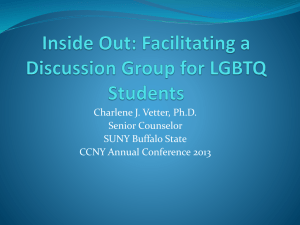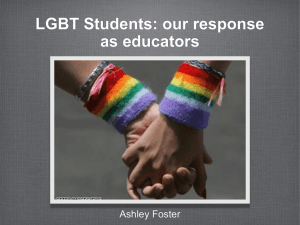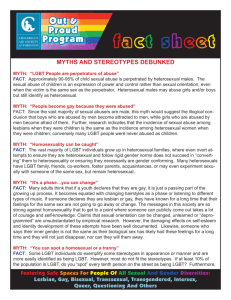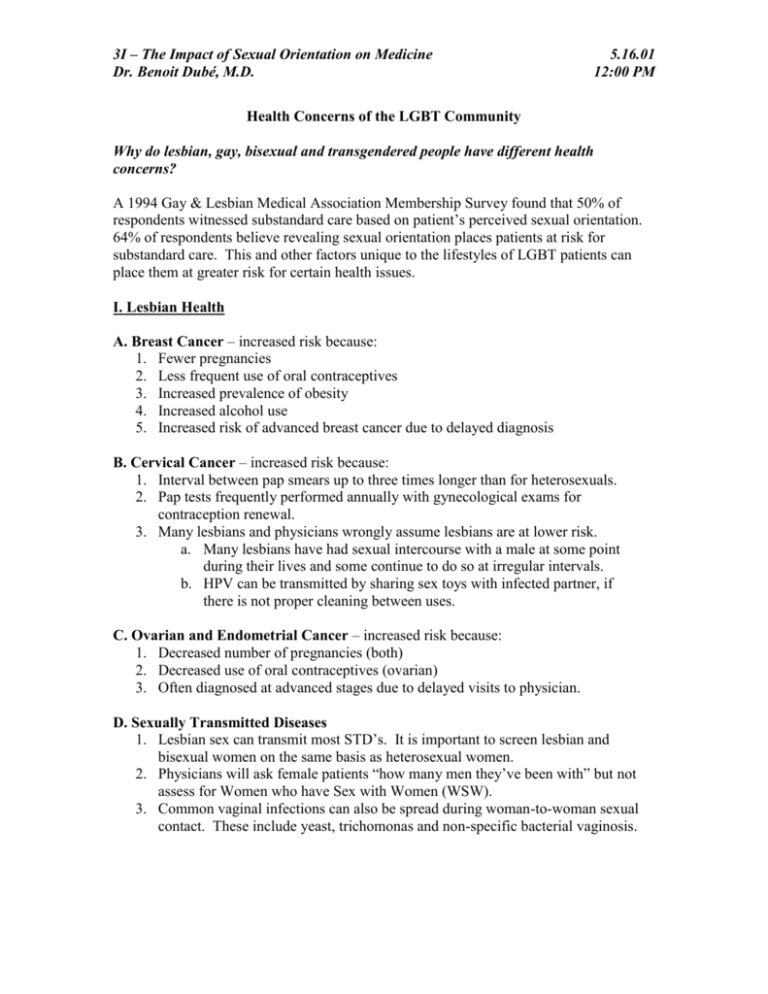
3I – The Impact of Sexual Orientation on Medicine
Dr. Benoit Dubé, M.D.
5.16.01
12:00 PM
Health Concerns of the LGBT Community
Why do lesbian, gay, bisexual and transgendered people have different health
concerns?
A 1994 Gay & Lesbian Medical Association Membership Survey found that 50% of
respondents witnessed substandard care based on patient’s perceived sexual orientation.
64% of respondents believe revealing sexual orientation places patients at risk for
substandard care. This and other factors unique to the lifestyles of LGBT patients can
place them at greater risk for certain health issues.
I. Lesbian Health
A. Breast Cancer – increased risk because:
1. Fewer pregnancies
2. Less frequent use of oral contraceptives
3. Increased prevalence of obesity
4. Increased alcohol use
5. Increased risk of advanced breast cancer due to delayed diagnosis
B. Cervical Cancer – increased risk because:
1. Interval between pap smears up to three times longer than for heterosexuals.
2. Pap tests frequently performed annually with gynecological exams for
contraception renewal.
3. Many lesbians and physicians wrongly assume lesbians are at lower risk.
a. Many lesbians have had sexual intercourse with a male at some point
during their lives and some continue to do so at irregular intervals.
b. HPV can be transmitted by sharing sex toys with infected partner, if
there is not proper cleaning between uses.
C. Ovarian and Endometrial Cancer – increased risk because:
1. Decreased number of pregnancies (both)
2. Decreased use of oral contraceptives (ovarian)
3. Often diagnosed at advanced stages due to delayed visits to physician.
D. Sexually Transmitted Diseases
1. Lesbian sex can transmit most STD’s. It is important to screen lesbian and
bisexual women on the same basis as heterosexual women.
2. Physicians will ask female patients “how many men they’ve been with” but not
assess for Women who have Sex with Women (WSW).
3. Common vaginal infections can also be spread during woman-to-woman sexual
contact. These include yeast, trichomonas and non-specific bacterial vaginosis.
3I – The Impact of Sexual Orientation on Medicine
Dr. Benoit Dubé, M.D.
5.16.01
12:00 PM
E. Reproductive Health
1. Needs should be discussed outside implied heterosexual activity.
2. Fertility Assistance – possible for one woman to have her eggs harvested,
inseminated, and the resulting embryo(s) implanted in her partner's uterus, so that
both women can be biological parents.
3. Seeking a court’s validation of both women as legal parents may be advisable.
II. Gay Men’s Health
A. Anal Cancer – gay men are at increased risk; unrelated to HIV/AIDS, related to HPV
B. HIV Related Cancers
1. Kaposi’s Sarcoma (KS) – caused by HHV-8, antiretroviral therapies effective
2. Non-Hodgkin’s Lymphoma – increased incidence and association with HIV+
3. HIV+ men are at greater risk because:
a. Immunocompromised patients have higher incidence of cancer.
b. Decreased CD-4 count associated with increased progression to cancer.
C. HIV – while no longer the primary population effected by HIV, HIV/AIDS continues
to have a profound effect both physically and psychologically on this community
1. LGBT Youth represent a subgroup of all MSM who are particularly likely to
engage in high-risk behavior, and so are particularly at risk for HIV.
2. CDC (1999) identified youth (ages 13-24) as the single most likely group to
contract an STD, with 30% of new HIV infections reported as MSM.
3. Significantly higher percentage of African American and Latino youth being
infected with HIV than white youth.
4. Risks of female-female HIV transmission remains underresearched, although
most HIV+ women report having both male and female sexual partners
D. Eating Disorders
1. Eating disorders are not uncommon in gay male culture where, in many parts of
the community, there is high pressure to conform to physical and aesthetic ideals.
2. Study of 135 men treated for eating disorders at Massachusetts General Hospital
found 42% of bulimic patients identified as homosexual or bisexual.
III. Transgendered Health
A. Male to Female (MTF) Transsexuals – do not have prostate removed when they
have reassignment surgery, at possible risk for Prostate Cancer.
B. Female to Male (FTM) Transsexuals – still have at risk of Breast Cancer in spite of
breast reduction surgery.
3I – The Impact of Sexual Orientation on Medicine
Dr. Benoit Dubé, M.D.
5.16.01
12:00 PM
IV. LGBT Adolescents
A. Suicide
1. Suicide is a leading cause of death, especially of questioning/gay male
adolescents.
2. Nearly 33% of all adolescent male suicide attempts are linked to a crisis over
sexual orientation.
B. LGBT Youth may be denied the “Rites of Passage” characteristic of adolescence.
2. “Rites of Passage” unique to adolescence such as:
a. Classroom romances, first date, first kiss, Senior Prom
b. No role models or relationship models to look up to
c. No healthy outlets for sexual exploration
3. Failure to experience these activities stifles the normal social development of
LGBT Youth, even if they pass as heterosexual.
C. Violence – violence against youth is frequent and has significant impact.
V. General Health
A. Substance Abuse
1. Alcoholism among gay men and lesbians reaches 30%
2. National rate of tobacco use among adults: 25% (CDC, 1997)
Rate of tobacco use by gay adult men: 41% (Stall, et. al. 1999)
Rate of tobacco use by lesbians: 28% (Stall, et. al. 1999)
3. Gay Men and Lesbians 2-3 times more likely to engage in SA because:
a. Escape social stressors of homosexuality
b. Limited number of LGB Safe Spaces usually include a bar/club, which
increases exposure to “club drugs”
c. Peer pressure in LGBT adolescents to find acceptance
B. Domestic Violence
1. Physicians often do not screen same sex couples for DV.
2. DV rates are estimated to be similar in homosexual and heterosexual couples.
C. Hate Crimes
1. LGBT individuals are at higher risk for physical assault and violence
2. Settings: schools, colleges, armed services, jails, in work and public places
D. Barriers to Health Care for LGBT Patients (Access to Care)
1. Institutionalized bias in health insurance and public entitlements, which routinely
fail to cover gay and lesbian partners. (ie. Medicaid, Social Security)
Denial of Domestic Partner Benefits creates a barrier to access.
Both partners must ensure employment with health insurance coverage.
Prevents stay-at-home parenting by one partner.
2. Lack of partner visitation rights in ICUs and EDs.
3I – The Impact of Sexual Orientation on Medicine
Dr. Benoit Dubé, M.D.
5.16.01
12:00 PM
3. Medical decision making rights – partner vs. family
4. Lack of trust and understanding in Physician-Patient Relationship because patient
fears substandard care, confidentiality issues if they disclose sexual orientation.
5. LGBT patients more likely to remain silent about important health issues they fear
may lead to stigmatization (Schatz & O’Hanlan, 1994; Bradford & Ryan, 1988;
Bockting, et.al., 1998)
VII. Summary
Bias is pervasive.
Quality of care is affected.
Education and training is inadequate.
Communication and disclosure are significant issues.
Physician discomfort around issues of sexuality is evidenced by the fact that
several studies indicate that only 11% to 37% of primary care physicians routinely
take a sexual history from new adult patients.
Be aware of the issues so that you can provide the best care possible to your
patients regardless of sexual orientation!
References
Bockting WO, Robinson BE, Rosser BRS. Transgender HIV prevention: a qualitative
needs assessment. AIDS Care. 1998;10(4):505-526.
Bradford J, Ryan C. The National Lesbian Health Care Survey. National Lesbian
and Gay Health Foundation, Washington, DC, 1988:76-85.
Centers for Diseas Control. HIV/AIDS Among Racial/Ethnic Minority Men Who Have
Sex with Men – United States, 1989-1998. MMWR. Jan 2000;49(1).
Centers for Disease Control. Cigarette smoking among adults – United States, 1997.
Morbidity and Mortality Weekly Report 18(43):993-996, 1999.
Centers for Disease Control and Prevention. Kaposi’s sarcoma and Pneumocystis
pneumonia among homosexual men – New York City and California. MMWR.
1981;30:305-308.
Schatz B, O’Hanlan K. Anti-Gay Discrimination in Medicine: Results of a
National Survey of Lesbian, Gay and Bisexual Physicians. American Association
of Physicians for Human Rights/Gay Lesbian Medical Association, San Francisco,
May 1994






